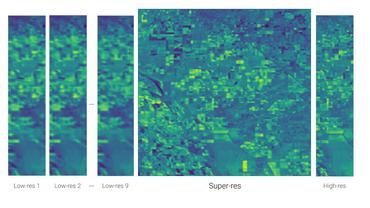Image Super-Resolution
610 papers with code • 61 benchmarks • 39 datasets
Image Super-Resolution is a machine learning task where the goal is to increase the resolution of an image, often by a factor of 4x or more, while maintaining its content and details as much as possible. The end result is a high-resolution version of the original image. This task can be used for various applications such as improving image quality, enhancing visual detail, and increasing the accuracy of computer vision algorithms.
Libraries
Use these libraries to find Image Super-Resolution models and implementationsSubtasks
Most implemented papers
Photo-Realistic Single Image Super-Resolution Using a Generative Adversarial Network
The adversarial loss pushes our solution to the natural image manifold using a discriminator network that is trained to differentiate between the super-resolved images and original photo-realistic images.
Perceptual Losses for Real-Time Style Transfer and Super-Resolution
We consider image transformation problems, where an input image is transformed into an output image.
Image Super-Resolution Using Deep Convolutional Networks
We further show that traditional sparse-coding-based SR methods can also be viewed as a deep convolutional network.
Enhanced Deep Residual Networks for Single Image Super-Resolution
Recent research on super-resolution has progressed with the development of deep convolutional neural networks (DCNN).
ESRGAN: Enhanced Super-Resolution Generative Adversarial Networks
To further enhance the visual quality, we thoroughly study three key components of SRGAN - network architecture, adversarial loss and perceptual loss, and improve each of them to derive an Enhanced SRGAN (ESRGAN).
SinGAN: Learning a Generative Model from a Single Natural Image
We introduce SinGAN, an unconditional generative model that can be learned from a single natural image.
Real-Time Single Image and Video Super-Resolution Using an Efficient Sub-Pixel Convolutional Neural Network
This means that the super-resolution (SR) operation is performed in HR space.
Beyond a Gaussian Denoiser: Residual Learning of Deep CNN for Image Denoising
Discriminative model learning for image denoising has been recently attracting considerable attentions due to its favorable denoising performance.
Image Super-Resolution Using Very Deep Residual Channel Attention Networks
To solve these problems, we propose the very deep residual channel attention networks (RCAN).
Deep Back-Projection Networks For Super-Resolution
The feed-forward architectures of recently proposed deep super-resolution networks learn representations of low-resolution inputs, and the non-linear mapping from those to high-resolution output.






























































 ImageNet
ImageNet
 KITTI
KITTI
 CelebA
CelebA
 FFHQ
FFHQ
 CelebA-HQ
CelebA-HQ
 BSD
BSD
 DIV2K
DIV2K
 Urban100
Urban100
 VGGFace2
VGGFace2
 Set14
Set14



